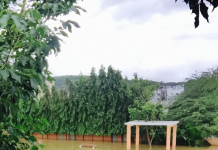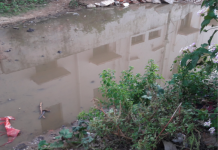Look at the photograph below. What do we see? Doesn’t this look like a nice country neighbourhood with green pastures? At the same time, we also see a towering residential community behind this greenery. People living here would have excellent view of the fields and lakes everyday. Idyllic, rural landscape in a city; Best of both worlds. Isn’t it?

Now, let’s look at the same location from a different angle to see like Sherlock Holmes!

What do we see now?
We observe quite a bit from this photograph. The greenery that the buildings are in, looks like they are constructed on a wetland. So has it been destroyed to make way for this construction? The residential complex looks like it has around 800 houses. Where are they getting water from? Is it ground water or water from tanker lorries? What would be the amount of waste generated everyday by people living here? How is being disposed? Is the waste being segregated? What would energy consumption be? And, the list goes on! This is what we call as ‘Seeing’ a social problem. It is the capacity to look at a seemingly normal scenarios and find social problems in them.
If you look back in time from the days of industrial revolution, the world has been shaped by people who had the ability to identify problems. Be it from the invention of a light bulb to the idea of segregating waste. Identifying a problem is invariably the beginning for numerous people; from scientists to social entrepreneurs, and from freedom fighters to fashion designers. The world has become a better place because of them. Today, we can’t expect only a select group of people to solve public problems. We need a generation of dutiful citizens who can identify, understand and solve the looming issues that prevail in every corner of the world. This is the need of the hour when many of us are apathetic to social issues.
We can chuck the apathy in us and become empathetic towards social issues by following a few simple steps.
Learn about the 17 global goals that the United Nations have put together. They are the most pressing issues of the 21st century. We can know more about it at www.globalgoals.org
Take the ‘Seeing the problem’ picture quiz. Look at the images in the gallery link below and identify the social problems in each photograph. Connect them back the global goals.
Go for a walk in your neighbourhood by wearing the hat of a ‘Social problem observer’. Carry a notebook and pen with you to make notes and sketch the problem you see.
If you are studying in school, talk to your parents about ‘Seeing a problem’. Take them for a walk along with you.
Form a group and go for a walk in your neighbourhood. You can even record a video using your smartphone in which one of the team members could present about the social problem in front of the camera.
Reflect upon the problem you have identified and imagine a scenario where the problem is solved.
Report your “Neighbourhood walk” story to us at [email protected]
Remember that, when we start to see social problems around us, we start to perceive world in a different way. Be it an open drain at the end of your street, a bad road in your neighbourhood, or segregation of waste, they can all be solved with your involvement. Start becoming a problem solver, and contribute to the society.






